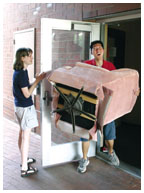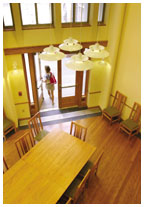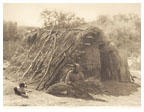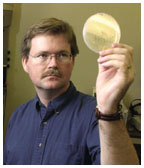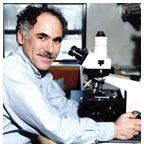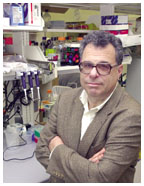October 6, 2004: Notebook
And so it begins
The semester gets under way with old and new traditions
Breaking ground: chemical engineering
Proteins on the (self-)cutting edge
Class of 2008 Men 53.4% Minority: |
And
so it begins
The semester gets under way with old and new traditions
The week before bleary-eyed freshmen shuffled into their first lectures on Sept. 9, Baker Rink hosted the yearly crush of housing registration. First-years were easy to spot: They walked hesitantly to the check-in table, noses buried in campus maps, parents in tow. Smug sophomores strutted about effortlessly. Jaded juniors signed in, dumped their belongings in dormitory common rooms, and gallivanted out to Prospect Avenue. Seniors, for the most part, picked up their dorm keys with anticipation and melancholy — this year is their last at Princeton.
The education of a Princetonian begins gradually, over days of intensive initiation. This September, many members of the Class of 2008 returned from Outdoor Action or Community Action trips exhausted and grungy, but bonded to at least a few of their classmates. They faced a week of activities: Historical campus tours. Ultimate Frisbee games. The Triangle Club show. A cappella performances. Language placement exams. Lessons in singing “Old Nassau.” Departmental open houses. To most people, the list might have seemed daunting.
Timothy Hsia ’06, an ecology and evolutionary biology major, manages a laugh as he maneuvers a chair for his brother Stephen Hsia ’08. Lucy Jacobson ’06 holds the door. (John Jameson ’04) |
But the 1,175 members of the Class of 2008, according to the admission office, are hot stuff: More than 53 percent fall in the highest-ranked category of academic ability. A record 52 percent are receiving need-based financial aid.
The headliner of this year’s freshman class assembly was Nobel laureate Daniel Kahneman, the Eugene Higgins Professor of Psychology. Kahneman’s lecture about “the wonders and the flaws of intuitive thinking” was followed by discussion groups in the residential colleges. This arrangement was, for many, an introduction to Princeton’s life of the mind — echoing the words of President Tilghman, who affirmed at Opening Exercises that “knowledge springs from dialogue.” She also delivered pointed advice to the new class: “It is tempting to fall back on what is familiar and safe. Don’t do it.”
Even the greenest freshmen seemed to grasp that there is a time for solemn sobriety, and there is a time for Prospect Avenue. Between check-in and the start of classes five days later, the eating clubs served up social smorgasbords nightly. Before long, dancing and cavorting at 2 a.m. became the most widespread diversion among newly arrived undergraduates. Meanwhile, the University’s peer educator program, which deals with issues of sexual harassment and assault, sponsored “Sex on a Saturday Night,” a light-hearted treatment of the darker side of the dating scene. Attendance at the play — a series of student-performed skits featuring overzealous upperclassmen with corny pickup lines, a less-than-amorous encounter during a night of severe intoxication, and a good-guy Romeo who nearly gets taken advantage of — was mandatory for all freshmen.
“The hardest part about Princeton so far,” lamented Ross Urken ’08, while waiting in line to have his laptop adjusted at the ever-popular Office of Information Technology, “is meeting new people and remembering all their names.” He turned to a companion sitting on the next bench. “After all these events, I’m just incredibly exhausted.”
“Don’t worry,” the companion reassured him. “Things
will become normal when classes start.” ![]()
Jordan Paul Amadio ’05

(Denise Applewhite/Office of Communications) |
Pre-Rade,
the newest tradition Members of the Class of 2008 celebrated their status
after Opening Exercises by parading through FitzRandolph Gate onto Nassau
Hall’s front lawn. Freshmen streamed up the walk, passing members
of the Classes of 2005, 2006, and 2007 and occasionally exchanging high-fives
with them. ![]()

The University chose sustainable bamboo for the hardwood floors in common areas and student residences at the ellipse dorm, to be named for Emma B. Bloomberg ’01. (Frank Wojciechowski) |
September marked the opening of what’s now known as Ellipse Hall, a 90,000-square-foot residence hall on the edge of Poe and Pardee fields that will house 220 juniors and seniors this year. From the outside, the new dormitory appears modern and symmetric, but inside, it has a character derived from some of the older residence halls on campus. “The rooms are kind of like collegiate gothic rooms in that every room is just a little bit different,” says Anne St. Mauro, director of the University’s office of design and construction. The building’s hardwood floors, also reminiscent of the collegiate gothic style, have a modern, environmentally sensitive twist: They’re made of bamboo, a material chosen for both durability and sustainability.
The dorm completes the three-building curve started by neighboring Scully Hall and the Carl Icahn Laboratory. Taking advantage of the site’s southern exposure, designers from Michael Dennis Associates of Boston incorporated large windows and skylights to draw in natural light. In addition to residential space and common areas, the hall has rehearsal facilities for singing groups, instrumental music practice rooms, a dance studio, and a new home for WPRB radio, which had been broadcasting from Holder Hall for the last 58 years. At the center of the building, the wide archway, which was opened for Reunions in May, will be a fixture on future P-rade routes.
In September, the University confirmed that a gift from the family of
New York City mayor Michael Bloomberg funded part of the ellipse dorm’s
construction, which began in 2002 and was completed shortly before students
arrived on campus. The building will be named for Bloomberg’s daughter,
Emma B. Bloomberg ’01, this semester. ![]()
By B.T.

FYI:
Findings
Testing
the test
How much information does the SAT provide
about a student’s future performance in college?
Not as much as previous estimates suggested, says economics professor
Jesse Rothstein. In a paper published in the Journal of Econometrics,
he questions the source of the test’s predictive power. Student
and high school demographics influence existing models, overstating the
correlation between students’ SAT scores and freshman grade-point
averages, he says. Rothstein’s adjusted model, applied to a data
set from the University of California, found the predictive value of the
SAT to be 20 percent lower than estimates generated by traditional models.
Impressive impressions
A team led by engineering professors Stephen Chou and Stephen Lyon has
found a way to mass-produce memory chips and electronic components so
small that they are at the limit of what can be viewed by the most powerful
microscopes. Using a technique called nanoimprinting, invented by Chou
in 1994, the researchers can press a mold into a layer of plastic on a
silicon wafer to make microscopic patterns 5 millionths of a millimeter
wide on the plastic surface. The patterns are then transferred to silicon,
where they could form the basis of miniature electronic circuits.
The joy of hex
Computer science major Ryan Teising ’04 didn’t make a game
out of his senior thesis; he made his senior thesis out of a game. Teising
developed an algorithm to beat advanced players of the Game of Hex, a
board game played on a trapezoidal grid of hexagons. He used the algorithm
to create an optimal player in an online version of the game. The Game
of Hex was invented independently by two mathematicians in the 1940s,
one of whom was Princeton graduate student John Nash *50. Web users can
test their skills against Teising’s computer player at www.princeton.edu/~rteising/
Hex/hex.html. ![]()

Photo: Princeton University Library |
A panel discussion called “Election 2004” takes place Oct. 6 at 4:30 p.m. in Dodds Auditorium. David E. Lewis, assistant professor of politics and public affairs, will moderate the panel, which includes Larry Bartels, Donald E. Stokes Professor of Public and International Affairs; Mickey Edwards, lecturer of public and international affairs and former Republican congressman; and Paul Krugman, professor of economics and international affairs.
Computer science professor edward Felten will talk about digital media at 4:30 p.m. Oct. 12 in Friend 101. In his lecture, “Rip, Mix, Burn, Sue: Technology, Politics, and the Fight to Control Digital Media,” Felten will discuss the multi-front battle to control the future of digital media and innovation, and the consequences of that battle for ordinary citizens.
Marjorie Miller, managing editor of the foreign desk at the Los Angeles Times, will lecture Oct. 13 as part of the series “Journalists Writing the World,” moderated by politics professor Gary Bass, in Bowl 016 in Robertson Hall. The series, says Bass, brings to Princeton journalists who have prodded readers “to grapple with painful and complicated issues.” Other visitors will include Trudy Rubin (Nov. 22), Steve Coll (Nov. 29), Philip Gourevitch (Dec. 1), Anne-Marie Squeo (Dec. 6), James Bennet (Feb. 10), and Peter Baker and Susan Glasser (March 21).
American Indian photographs.
On display at Firestone Library through Oct. 24 are 24 photographs taken
by Edward Curtis (1868-1954), who documented the American Indian way of
life before it was subsumed by Anglo culture. His work of three decades
formed a 20-volume series called The North American Indian, a copy of
which the University owns. These photogravures are a small fraction of
the University’s Curtis collection, which was given by J. Pierpont
Morgan and is available for viewing by appointment at the Department of
Rare Books. ![]()

In his lab, chemical engineering professor David Wood examines an agar plate for colony formation, allowing him to quickly identify useful intein mutants. (Frank Wojciechowski) |
Breaking
ground: chemical engineering
Proteins
on the (self-)cutting edge
If proteins are the building blocks of life, inteins are the blocks that accidentally slipped under the couch. Recently discovered and still relatively unknown, the self-splicing “intervening proteins” are just beginning to find their way into molecular biology textbooks. And for chemical engineering professor David Wood and others who study them, inteins offer exciting and wide-ranging possibilities, from purifying proteins in the lab to helping drugs reach their targets in humans without harming the rest of the body.
Wood, who double-majored in biology and chemical engineering as an undergraduate at Cal Tech, began working with inteins in 1993, just three years after they were discovered by three independent labs. Wood brought his work to Princeton in 2001 and earlier this year received a National Science Foundation CAREER grant to aid his research. Inteins are fascinating protein sequences because they remove themselves from larger proteins. When triggered by changes in acidity or temperature, they cut themselves out, allowing the remaining pieces of protein, known as exteins, to join together and create a new protein. About 200 inteins have been identified, mostly in simple, single-cell organisms.
Wood has designed innovative new inteins, including one with a splicing mechanism triggered by the presence of human thyroid hormone. Instead of being controlled by pH or temperature, the intein responds to a biological molecule. Wood created the intein by inserting the DNA for the human thyroid receptor protein, and the results of his work will be published in Protein Science later this year.
Biological control of inteins could eventually lead to a host of applications, including drug delivery. Theoretically, inteins could neutralize toxic proteins, such as chemotherapy drugs, until they reach target cells or tumors, and then activate the drugs by self-splicing. But pharmaceutical uses will require precise, predictable inteins, and, Wood says, “very tightly controllable inteins just don’t exist yet.”
In the meantime, inteins are playing a valuable role in the lab, helping to purify protein samples. When researchers want to produce and study a protein, they put its DNA into a simple organism, such as e coli, to grow the protein. Reproducing the protein is relatively easy, but extracting it is more difficult. To make the process easier, researchers attach an affinity tag, a sort of molecular hook to grab onto when pulling out the protein. But affinity tags eventually must be removed from the protein. “That, it turns out, is a real problem, both in research and in large-scale use of the technology,” Wood says. When an intein is inserted between the protein and the affinity tag, though, simply shifting the pH of the protein solution can separate the tags.
Wood has employed his engineering expertise and his knowledge of inteins
to find efficient and cost-effective purification processes, including
one that has been submitted for a provisional patent. And as protein science
continues to make strides, inteins are keeping pace. More than 400 intein-related
papers have been published in the last 10 years, a tally that is both
motivating and challenging for Wood. “It’s great to be in
an exciting field,” he says, “but it’s incredibly stressful.
For virtually every project that’s going on in my lab, I can name
at least one other researcher in this country who’s trying to do
the same thing.” ![]()
By B.T.

(Courtesy Lee Silver) |
“Almost every food we eat has carcinogenic chemicals in them, and they’re not there by accident. Presumably, plants have evolved these chemicals to protect themselves from pests.”
Molecular biology and Woodrow Wilson School professor Lee Silver refuting
the notion that “organic” foods protect consumers from harmful
chemicals, in a Sept. 14 lecture about bioethics. A cup of organic coffee,
he said, contains more than a dozen known carcinogens. ![]()

(Image courtesy Robert Vanderbei) |
Looking at USA Today’s county-by-county map of the presidential election results in 2000, one could easily see the United States as a nation divided: red and blue, Republican and Democrat, and little in between. But after seeing the data behind the newspaper’s graphic, professor Robert Vanderbei was less convinced.
As an instructor in ORF 201: Computer Methods for Problem Solving, Vanderbei has a talent for creating graphical representations of data, and the USA Today map did not seem to be the best way to illustrate the voters’ choices. For example, in Mercer County, which includes Princeton, 62 percent of voters supported Al Gore. In nearby Monmouth County, only 50.4 percent voted for the former vice president. On the map, both counties were shaded with the same Democratic blue.
Using the county-by-county election returns and latitude and longitude
coordinates for county boundaries provided by the U.S. Census Bureau,
Vanderbei programmed a Java graphic that uses the colors of a computer
monitor — red, blue, and green — to illustrate votes for George
W. Bush (red), Gore (blue), and Ralph Nader ’55 (green). So Mercer
County was shaded 62 percent blue, 35 percent red, and three percent green.
The overall result was an interesting array of purples, with the exception
of one greenish county in Utah and a few vacant areas in New England,
where results are compiled by town instead of county. Vanderbei plans
to illustrate the 2004 election results as well for a side-by-side comparison
as soon as data is available. Vanderbei’s 2000 map can be viewed
on the Web at www.princeton.
edu/~rvdb/JAVA/election2000/. ![]()
By B.T

David Botstein (Photo by Frank Wojciechowski) |
A fund has been established in memory of engineering student Melissa M. Huang ’07, who was found dead Sept. 5 in her dorm room by her parents and a custodian. As of mid-September, the cause of death was unknown. Preliminary results of an autopsy are inconclusive. Donations can be sent to: Melissa M. Huang ’07 Memorial Fund, Princeton University, c/o Nancy Kalmikoff, Gift Records, P.O. Box 5357, Princeton, NJ 08543-5357.
The National Institutes of Health selected Princeton as the home for a new research center devoted to using advanced computational methods to investigate complex biological systems.
The grant will provide $3 million in the first year and is expected to total $14.8 million over five years. The multidisciplinary initiative, called the Center for Quantitative Biology, will be headed by David Botstein, director of the Lewis-Sigler Institute for Integrative Genomics.
The center will focus on several fundamental research projects having to do with the early development of organisms, cell-to-cell communication, and the interaction of viruses with their host cells.
NASA has selected engineers at Princeton University
to develop an advanced rocket thruster that could send people or robots
to other planets with far less propellant than conventional engines. The
three-year, $4.4-million contract went to a team led by Edgar
Choueiri, associate professor of mechanical and aerospace
engineering, to develop an advanced rocket called a plasma thruster, which
does not burn fuel. Instead, such rockets produce superheated, electrically
charged particles, called plasma, and use electromagnetic forces to propel
the plasma particles from the thruster at a very high speed. ![]()


